As the season of Lent draws near, we will inevitably get asked the question, “So what are you doing for Lent this year?” Before we answer that question, we should take a moment to review what Lent is. Lent is a season of penance that last approximately 40 days. It begins on Ash Wednesday (February 14th in 2018) and ends on Holy Thursday (March 29th in 2018) and includes all days except Sundays. Taking a cue from Jesus, who spent 40 days fasting in the desert, this period is set aside by the church to deepen our spiritual lives through prayer, fasting, and almsgiving.
This time is also a call to join the spiritual battle that surrounds each person, every day. Huh? People who try to grow closer to Jesus are often tempted – either by their own nature or by the fallen an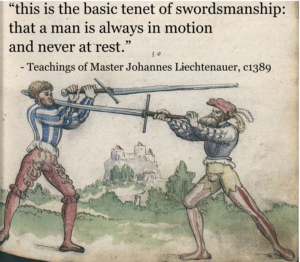 gels. The heart of spiritual combat is to overcome these temptations to sin because giving up on trying to grow your relationship with the Lord is not a viable option if heaven is your goal.
gels. The heart of spiritual combat is to overcome these temptations to sin because giving up on trying to grow your relationship with the Lord is not a viable option if heaven is your goal.
As the founder of the Order of Lepanto, not only do I look for inspiration from the saints but also from the great sword masters of the Medieval and Renaissance periods in my efforts to win this spiritual battle. One of my favorite quotes is from the teachings of Master Johannes Liechtenauer — “this is the basic tenet of swordsmanship: that a man is always in motion and never at rest.” This is strikingly applicable in both martial arts and the faith life – we must always be in motion, growing ever closer to God.
How to approach Lent?
Like any good general in a battle, you need to approach Lent with a plan. The better the plan is, the more likely you are to be successful.
While Lent is a penitential season, and as such we need to practice penance, we can (and should) take time to introduce new things that will have a positive impact on our overall faith life. My approach is to start with identifying my biggest current spiritual challenge, which changes from year to year, and to discern which elements of fasting, prayer, and almsgiving would work the best to address it. Then, as a step two, I identify ways for a particular element to feed and enhance the others. For example, one might choose to fast from television for a couple of nights per week and to skip the expensive coffees by brewing some at home instead. With that fast as a start, you can create a short prayer to say every time you are tempted to watch TV or to buy a Mocha Latte. You might then take the time freed up by not watching TV to spend time with your spouse, to engage in spiritual reading, or to say a rosary. Finally, you can use the money saved from skipping the $5 coffees to support your favorite ministry, pro-life group, or apostolate like the Order of Lepanto. In that way, you can extend a practice in one area to bear fruit across all of them.
However, like any battle, once you are engaged your opponent does unexpected things. (If you doubt this, come see a sparring match sometime!) In that case, you need to regroup. It’s okay to take a step back once you realize that you fell short in a particular instance. Ask God to help you figure out what went wrong, then use your intellect to review what happened and strategize ways to avoid that pitfall in the future. The most important step at this point is to not to lose heart and give up. A lesson from the sword fighting aspect of the apostolate: I have seen many people get flustered or dejected when they lose the first point (or 2) to their opponent. They begin to believe that they cannot win and then it becomes a self-fulfilling prophecy. The really good sword fighters can shake off losing that point and come back strong.
Suggestions
With all of that in mind, we are now ready to address our original question, “What are you doing for Lent?” If you are a member of the Order of Lepanto or thinking about becoming one, I recommend reading The Spiritual Combat by Dom Lorenzo Scupoli this Lent, if you have not already done so. I also recommend spending time practicing basic swordsmanship — master guards, master cuts, stance transitions, and flourishing. For general fitness and prayer time, you might consider a pushup rosary – 1-5 pushups after each Hail Mary and 5-10 sit-ups per Our Father.
Here are some other suggestions for everyone:
| Additional Prayer time by yourself, with your spouse, or with your family | Spiritual reading by yourself, with your spouse, or with your family | Family rosary | Individual or family catechetical study |
| Marriage study (even if you are single and only thinking about marriage) | Dedicate more time to your favorite apostolate or ministry | Attend a daily Mass | Stations of the Cross every Friday |
| Fast from social media | Go to confession | Chaplet of Divine Mercy | Fast from favorite food or drink |
| Fast from secular TV, radio, etc. | Add Catholic media – radio, TV to your regular schedule | Bible reading | Fast from eating out |
| Make plans to attend a conference or retreat | Pray the Angelus every day | Make daily prayer a priority | Fast on all Fridays in Lent |
| Forgive someone who hurt you in the past | Reunite with extended family | Be intentional about the time you spend with your immediate family | Increase exercise (or practice those sword skills!) |
Remember, though, to find an area of spiritual weakness and then find a spiritual practice to address it. A good battle plan will lead to better results!
Deo Gratias!
 A person who has a wooden sword will need to have boiled linseed oil to regularly treat the sword.
A person who has a wooden sword will need to have boiled linseed oil to regularly treat the sword. Oil to prevent rust – you can use a gun oil or a sword oil for this
Oil to prevent rust – you can use a gun oil or a sword oil for this A flat metal file with a medium grit to dress nicks in the edge
A flat metal file with a medium grit to dress nicks in the edge And a way to store the sword when not in use that will protect it from rust. I recommend using a gun sock made for rifles, they are inexpensive and the length is just right.
And a way to store the sword when not in use that will protect it from rust. I recommend using a gun sock made for rifles, they are inexpensive and the length is just right. x gloves by Magid. These gloves offer good protection to all 5 fingers, knuckles, and the back of the hand.
x gloves by Magid. These gloves offer good protection to all 5 fingers, knuckles, and the back of the hand. A set of Original M-Pact gloves from Mechanix. Good protection for 4 fingers and knuckles, okay protection on the thumb and back of hand.
A set of Original M-Pact gloves from Mechanix. Good protection for 4 fingers and knuckles, okay protection on the thumb and back of hand.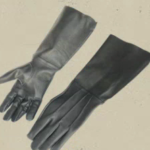 or basic leather one’s will do nicely.
or basic leather one’s will do nicely.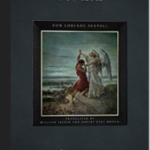 The Spiritual Combat by Dom Lorenzo Scupoli is the book that Saint Ignatius carried with him and that he read every day.
The Spiritual Combat by Dom Lorenzo Scupoli is the book that Saint Ignatius carried with him and that he read every day. A more modern book, the Manual for Spiritual Warfare by Paul Thigpen is a wonderful companion too.
A more modern book, the Manual for Spiritual Warfare by Paul Thigpen is a wonderful companion too. but a bladed Gauche would also have been seen.
but a bladed Gauche would also have been seen.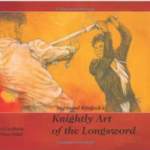 Sigmund Ringneck’s translation is a little dated, but the manual is easy to understand and gives an excellent foundational understanding of the longsword, which is the basis of all western martial arts.
Sigmund Ringneck’s translation is a little dated, but the manual is easy to understand and gives an excellent foundational understanding of the longsword, which is the basis of all western martial arts.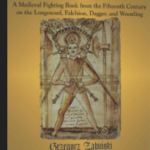 Codex Wallerstein gives another perspective on the longsword as well as adding in wrestling, dagger, and other weapons.
Codex Wallerstein gives another perspective on the longsword as well as adding in wrestling, dagger, and other weapons. Luckily there are a couple of affordable options from Absolute Fencing and Blue Gauntlet Fencing.
Luckily there are a couple of affordable options from Absolute Fencing and Blue Gauntlet Fencing.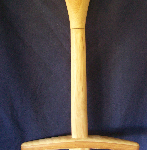
 orso Training Bag. This training tool was developed for unarmed martial arts, but it works quite nicely with a waster or a blunt steel sword.
orso Training Bag. This training tool was developed for unarmed martial arts, but it works quite nicely with a waster or a blunt steel sword. Another good choice is a Feder from Regenyei Armoury. These are good mid-tier swords.
Another good choice is a Feder from Regenyei Armoury. These are good mid-tier swords. Finally, there is the Tinker-Pearce Longsword from Hanwei. It is a beginners sword with a price to match. This one won’t last as long, but it is a way to spar with a real steel sword.
Finally, there is the Tinker-Pearce Longsword from Hanwei. It is a beginners sword with a price to match. This one won’t last as long, but it is a way to spar with a real steel sword. efore take unto you the armour of God, that you may be able to resist in the evil day, and to stand in all things perfect.
efore take unto you the armour of God, that you may be able to resist in the evil day, and to stand in all things perfect.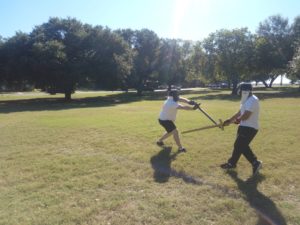 Martial Arts of Renaissance Europe (MARE), which is our group’s specific martial art, you see a similar understanding in other disciplines as well. Sifu Ted Wong from the New York Martial Arts Academy writes, “Footwork allows us to do 3 things: makes us hit harder, puts us in a position to hit, and gets us out of danger.” Even Bruce Lee spoke about the importance of your feet in combat: “The essence of fighting is the art of moving.”
Martial Arts of Renaissance Europe (MARE), which is our group’s specific martial art, you see a similar understanding in other disciplines as well. Sifu Ted Wong from the New York Martial Arts Academy writes, “Footwork allows us to do 3 things: makes us hit harder, puts us in a position to hit, and gets us out of danger.” Even Bruce Lee spoke about the importance of your feet in combat: “The essence of fighting is the art of moving.”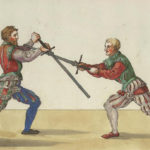 Cod.HS.3227a codex Hanko Dobringer writes this, “Before [Vor], After[Nach], Weak [Weich], Strong [Hart], in that instant/just as [Indes]. On these words hinge the whole art of Liechtenauer, and they are the foundation and cornerstone of all fencing on foot or on horseback, in armour [Harnusche] or without [Blos].” So the words are Before, After, Weak, Strong, and In the instant/moment.
Cod.HS.3227a codex Hanko Dobringer writes this, “Before [Vor], After[Nach], Weak [Weich], Strong [Hart], in that instant/just as [Indes]. On these words hinge the whole art of Liechtenauer, and they are the foundation and cornerstone of all fencing on foot or on horseback, in armour [Harnusche] or without [Blos].” So the words are Before, After, Weak, Strong, and In the instant/moment.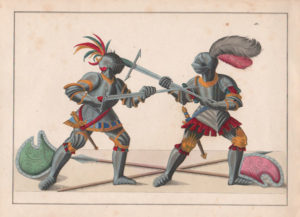 martial arts distilled down to five words. These base concepts span all of martial arts history and are as true today as they were in the 1300s. Okay, that’s great. If I get in a fight I know to use these as the basis of my strategic and tactical thinking, but how do these words have any relation to my life in general? Well, let’s look at this in light of our everyday life and then we will get into how we can use these words as the basis of our faith walk.
martial arts distilled down to five words. These base concepts span all of martial arts history and are as true today as they were in the 1300s. Okay, that’s great. If I get in a fight I know to use these as the basis of my strategic and tactical thinking, but how do these words have any relation to my life in general? Well, let’s look at this in light of our everyday life and then we will get into how we can use these words as the basis of our faith walk. the Christian worldview, we began to reduce the chances for life-threatening adversity and this resulted in a much better society overall. We cured more sicknesses, fed more people, and lowered infant mortality which helped to make the bare essential parts of life possible for a great number of people. The challenges then became advancing from subsistence to abundance. It can be argued that in modern society we are now providing more than subsistence and have encroached into satisfactory. While no one would argue that welfare is abundance, the level it does provide along with the way it is structured makes it easier just to stay at that level instead of becoming self-sufficient. Without that challenge of needing to lead and provide for a family, we have made couch potatoes. The Catholic Church, likewise, has responded to the reduction of challenges in our society by making it easier – the fast before receiving Holy Communion has been reduced to a bare minimum, Holy Days of Obligation are moved to Sunday so people don’t have to go Mass more than once per week, penance on Fridays has been downplayed until it has been all but obliterated, and the examples could go on. The central idea was that in making it easier to be Catholic, more people would choose to be in the faith. However, the reality is something quite different. Without the challenges presented by trying to live the traditional faith, people became spiritual couch potatoes. Jesus, who knows a thing or two about human nature, put out some amazing challenges for the faithful:
the Christian worldview, we began to reduce the chances for life-threatening adversity and this resulted in a much better society overall. We cured more sicknesses, fed more people, and lowered infant mortality which helped to make the bare essential parts of life possible for a great number of people. The challenges then became advancing from subsistence to abundance. It can be argued that in modern society we are now providing more than subsistence and have encroached into satisfactory. While no one would argue that welfare is abundance, the level it does provide along with the way it is structured makes it easier just to stay at that level instead of becoming self-sufficient. Without that challenge of needing to lead and provide for a family, we have made couch potatoes. The Catholic Church, likewise, has responded to the reduction of challenges in our society by making it easier – the fast before receiving Holy Communion has been reduced to a bare minimum, Holy Days of Obligation are moved to Sunday so people don’t have to go Mass more than once per week, penance on Fridays has been downplayed until it has been all but obliterated, and the examples could go on. The central idea was that in making it easier to be Catholic, more people would choose to be in the faith. However, the reality is something quite different. Without the challenges presented by trying to live the traditional faith, people became spiritual couch potatoes. Jesus, who knows a thing or two about human nature, put out some amazing challenges for the faithful: As part of my studies of the martial arts of Medieval and Renaissance Europe, I specifically looked at the history of knights, especially those of the Catholic Military Orders (e.g. The Knights of Saint John/Malta/Hospitaller, Teutonic Knights, etc.). In the course of that reading, I came across an article from Patrick Meehan, published at the Medievalists.net website in 2014. The author writes about the history of knights and how the actions of these historical figures runs the gamut from violent and destructive to the courtesies of courtly life. The author goes on to discuss the happenings in the lives of 3 different knights – an anonymous knight in the Teutonic Knights, Ulrich von Lichtenstein, and Jӧrg von Ehingen. The lives of these three men were distinctly different and spanned 200 years of history, but there was a common thread that linked them together and linked them to us – and the key to understanding that linkage lies in the Theology of the Body.
As part of my studies of the martial arts of Medieval and Renaissance Europe, I specifically looked at the history of knights, especially those of the Catholic Military Orders (e.g. The Knights of Saint John/Malta/Hospitaller, Teutonic Knights, etc.). In the course of that reading, I came across an article from Patrick Meehan, published at the Medievalists.net website in 2014. The author writes about the history of knights and how the actions of these historical figures runs the gamut from violent and destructive to the courtesies of courtly life. The author goes on to discuss the happenings in the lives of 3 different knights – an anonymous knight in the Teutonic Knights, Ulrich von Lichtenstein, and Jӧrg von Ehingen. The lives of these three men were distinctly different and spanned 200 years of history, but there was a common thread that linked them together and linked them to us – and the key to understanding that linkage lies in the Theology of the Body. Matrimony. God’s love has four components – it must be free, total, faithful, and fruitful. So to, should the love between spouses exhibit these four elements and marriages suffer when they are absent. First is freedom – we must be free to marry our spouse. Which means not only that we are not married to another, but also that we are not forcing our spouse to do something and we are able to forsake relations with all others. Next is total, the love must be total and one spouse should not say “I give you everything, except…” Totality also includes forever, which is why a prenuptial agreement is an impediment to a sacramental marriage as it presupposes failure and you have not committed to give your spouse your entire future. Faithfulness is third on the list and it should be clear, at least on the physical level, of the importance of faithfulness. This also refers to faithfulness in word and in thought – engaging in fantasies about others is unfaithful too. And finally fruitful, which describes how physical relations between spouses need to be open to life, though not necessarily timed to generate a life. This vision of spousal love is a total gift of self to the vocation of marriage – our work, our play, and our faith life are centered on our spouse and any children that arise from this union.
Matrimony. God’s love has four components – it must be free, total, faithful, and fruitful. So to, should the love between spouses exhibit these four elements and marriages suffer when they are absent. First is freedom – we must be free to marry our spouse. Which means not only that we are not married to another, but also that we are not forcing our spouse to do something and we are able to forsake relations with all others. Next is total, the love must be total and one spouse should not say “I give you everything, except…” Totality also includes forever, which is why a prenuptial agreement is an impediment to a sacramental marriage as it presupposes failure and you have not committed to give your spouse your entire future. Faithfulness is third on the list and it should be clear, at least on the physical level, of the importance of faithfulness. This also refers to faithfulness in word and in thought – engaging in fantasies about others is unfaithful too. And finally fruitful, which describes how physical relations between spouses need to be open to life, though not necessarily timed to generate a life. This vision of spousal love is a total gift of self to the vocation of marriage – our work, our play, and our faith life are centered on our spouse and any children that arise from this union.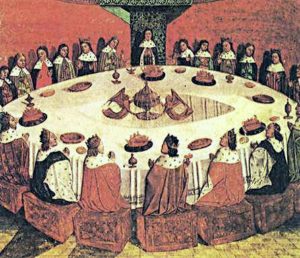
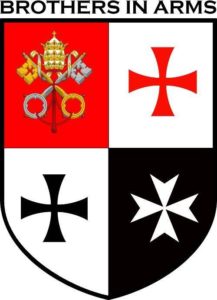
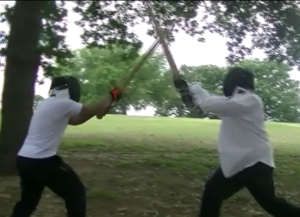 Before we get into how a martial arts practitioner combines faith and love with the art, we should talk a bit about what martial arts really are. First, there is a misconception that true martial arts are Asian; however, the truth is that the term “martial arts” is a European term that refers to the “arts of mars” – the Roman god of war. Therefore any system of self-defense is a “martial art”, including one’s which use modern weapons. The Europeans in the late-Medieval and Renaissance periods created a comprehensive system of self-defense that was documented in books – some of those were written by priests and monks, and many others written lay Catholics. As with any other skill, self-defense systems can be used for good or evil depending on the person.
Before we get into how a martial arts practitioner combines faith and love with the art, we should talk a bit about what martial arts really are. First, there is a misconception that true martial arts are Asian; however, the truth is that the term “martial arts” is a European term that refers to the “arts of mars” – the Roman god of war. Therefore any system of self-defense is a “martial art”, including one’s which use modern weapons. The Europeans in the late-Medieval and Renaissance periods created a comprehensive system of self-defense that was documented in books – some of those were written by priests and monks, and many others written lay Catholics. As with any other skill, self-defense systems can be used for good or evil depending on the person. define love? Since you, the reader, are English-speaking you realize that English uses “love” to describe many different feelings. For instance, “I love pizza” has a totally different meaning than “I love my wife”, which describes a different feeling from “I love my parent/child/sibling.” In other languages that catch-all word of love, gets translated into separate words to more accurately describe the feeling. In Greek (which is what much of the New Testament was written in) we would use Agape, Phileo, Storge, and Eros in place of the English “love.” You can find good explanations at many places on the internet, so I won’t delve into that here (this
define love? Since you, the reader, are English-speaking you realize that English uses “love” to describe many different feelings. For instance, “I love pizza” has a totally different meaning than “I love my wife”, which describes a different feeling from “I love my parent/child/sibling.” In other languages that catch-all word of love, gets translated into separate words to more accurately describe the feeling. In Greek (which is what much of the New Testament was written in) we would use Agape, Phileo, Storge, and Eros in place of the English “love.” You can find good explanations at many places on the internet, so I won’t delve into that here (this 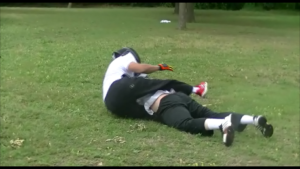 covered to our initial question – “How does a Catholic martial artist love his enemies?” The answer seems to be clear – although we do not show eros, phileo, or storge love to our enemies, we can show agape love. The essence of agape love is an exercise of the will, causing an action where we choose to do something that is in the best interest of another. A practitioner of a martial art who steps in to stop an unjust aggressor from harming an innocent person shows that innocent person agape love. The act of protecting another, while subjecting oneself to possible harm clearly meets that agape definition. If our fictitious doer-of-good-deeds only uses the amount of force necessary to stop the attack (even if that might require deadly force), you could make the argument that agape love was shown to the attacker through restraint. However as a further action, our protector in the story could offer forgiveness to the attacker and pray for his or her conversion (once the danger of aggression has been stopped) and show an even greater example of agape love.
covered to our initial question – “How does a Catholic martial artist love his enemies?” The answer seems to be clear – although we do not show eros, phileo, or storge love to our enemies, we can show agape love. The essence of agape love is an exercise of the will, causing an action where we choose to do something that is in the best interest of another. A practitioner of a martial art who steps in to stop an unjust aggressor from harming an innocent person shows that innocent person agape love. The act of protecting another, while subjecting oneself to possible harm clearly meets that agape definition. If our fictitious doer-of-good-deeds only uses the amount of force necessary to stop the attack (even if that might require deadly force), you could make the argument that agape love was shown to the attacker through restraint. However as a further action, our protector in the story could offer forgiveness to the attacker and pray for his or her conversion (once the danger of aggression has been stopped) and show an even greater example of agape love. I was reading an
I was reading an  the faithful to pray the Rosary for intention of victory, the commander of the Catholic forces ordered his men to pray the Rosary on the morning of battle before the fighting began, and finally the men carried their Rosaries into the battle. Indeed, the prayers of the faithful had been heard, but without the “yes” of those men, without their dedication to fighting against evil and for good the prayers could not have been answered. That very Catholic combination of works in faith is what made the victory possible.
the faithful to pray the Rosary for intention of victory, the commander of the Catholic forces ordered his men to pray the Rosary on the morning of battle before the fighting began, and finally the men carried their Rosaries into the battle. Indeed, the prayers of the faithful had been heard, but without the “yes” of those men, without their dedication to fighting against evil and for good the prayers could not have been answered. That very Catholic combination of works in faith is what made the victory possible. happens next in the story is just as important – once Frodo realized that the immediate danger had passed, he let down his guard. This happens to us too. We turn to God in the dark times, yet as soon as the situation improves we go back to ignoring Him (sometimes not even bothering to say thank you for His help). When we turn from prayer and action too soon, or for too long, the evil that had threatened, returns. In the story Shelob sneaks into a hiding place and sets a trap. Her next attack deprives Frodo of his phial and sword – unable to pray or to defend, he is quickly defeated. How often this occurs to us. We leave our prayer life and our taken by surprise by Satan and sin. Without the protection offered by the spiritual graces, we are quickly subdued and taken. If we are lucky, we have a friend like Samwise Gamgee who will pray for us, defend us, and rescue us when we are in the deepest need.
happens next in the story is just as important – once Frodo realized that the immediate danger had passed, he let down his guard. This happens to us too. We turn to God in the dark times, yet as soon as the situation improves we go back to ignoring Him (sometimes not even bothering to say thank you for His help). When we turn from prayer and action too soon, or for too long, the evil that had threatened, returns. In the story Shelob sneaks into a hiding place and sets a trap. Her next attack deprives Frodo of his phial and sword – unable to pray or to defend, he is quickly defeated. How often this occurs to us. We leave our prayer life and our taken by surprise by Satan and sin. Without the protection offered by the spiritual graces, we are quickly subdued and taken. If we are lucky, we have a friend like Samwise Gamgee who will pray for us, defend us, and rescue us when we are in the deepest need.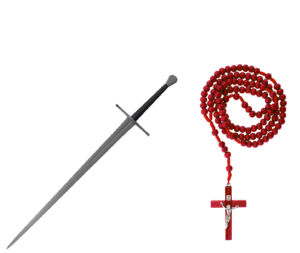 The mission of Order of Lepanto is to create an active movement of men, who enjoy physical activity and camaraderie in a setting that is faith-building. The decisiveness and audacity required to be a good martial artist is key to getting men prepared to defend their family, the Church, and the society from spiritual threats. When these skills are combined with an active prayer life, men gain the insight and wisdom to lead their families towards God. Our goal is to get men involved and connected with each other and the Church, while building their courage and confidence so as to give glory and honor to God.
The mission of Order of Lepanto is to create an active movement of men, who enjoy physical activity and camaraderie in a setting that is faith-building. The decisiveness and audacity required to be a good martial artist is key to getting men prepared to defend their family, the Church, and the society from spiritual threats. When these skills are combined with an active prayer life, men gain the insight and wisdom to lead their families towards God. Our goal is to get men involved and connected with each other and the Church, while building their courage and confidence so as to give glory and honor to God.